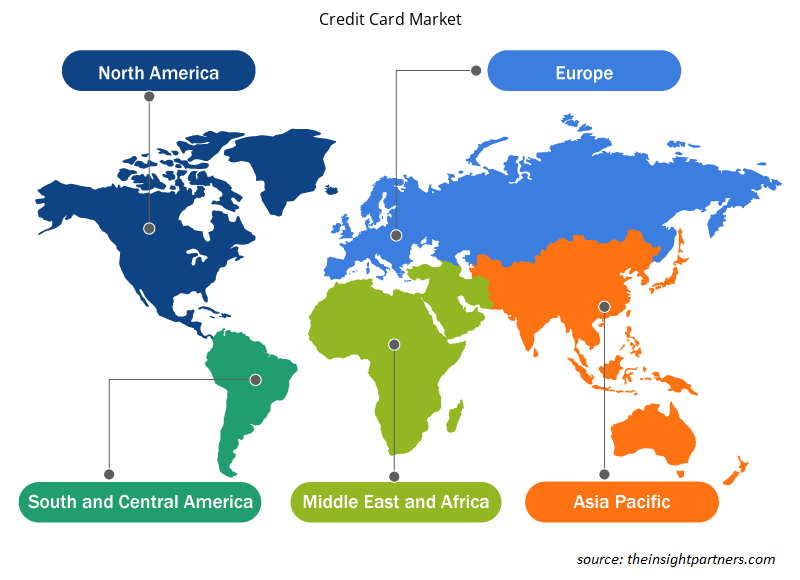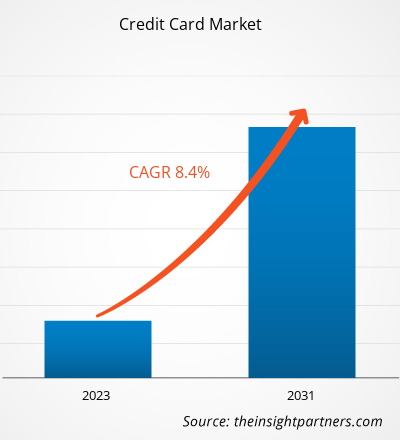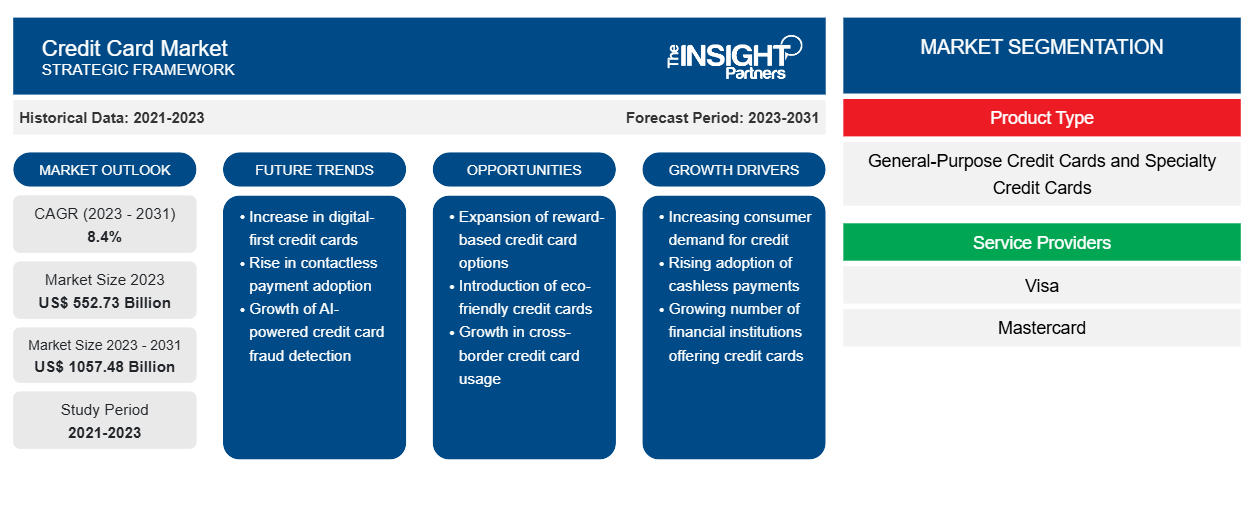Si prevede che le dimensioni del mercato delle carte di credito cresceranno da 552,73 miliardi di dollari nel 2023 a 1057,48 miliardi di dollari entro il 2031; si prevede che si espanderà a un CAGR dell'8,4% dal 2023 al 2031. La crescente domanda di comode alternative al contante è uno dei principali fattori che alimentano la crescita del mercato delle carte di credito.
Analisi del mercato delle carte di credito
Le carte di credito sono diventate sempre più popolari nel tempo per i loro numerosi vantaggi, tra cui una maggiore sicurezza rispetto alle carte di debito, un'elaborazione dei pagamenti più rapida, la possibilità di effettuare pagamenti senza interessi e altro ancora. Inoltre, il settore si sta espandendo a causa della rapida adozione delle carte di credito da parte dei consumatori finali per gli acquisti EMI e dell'aumento degli acquisti di vari beni costosi. Inoltre, offre ai consumatori finali garanzie estese e protezione degli acquisti, il che alimenta ulteriormente l'espansione del mercato. Il fatto che molte carte di credito forniscano anche protezione per viaggi, veicoli a noleggio e resi sta alimentando l'espansione del mercato delle carte di credito in tutto il mondo.
Panoramica del mercato delle carte di credito
- Una carta di credito è un sottile pezzo di carta di plastica o di metallo fornito da banche o società di servizi finanziari.
- Consente ai titolari di carta di prendere in prestito denaro per effettuare acquisti presso diversi rivenditori.
- Inoltre, le carte di credito offerte dalle banche e da altre società fintech consentono ai clienti di pagare vari servizi utilizzando la carta di credito anziché i contanti presso il punto vendita.
- Inoltre, la carta offre vari vantaggi, uno dei quali è che l'utente può anche convertire il suo acquisto in rate mensili e pagare di conseguenza, il che stimola ulteriormente la crescita del mercato delle carte di credito.
Personalizza questo report in base alle tue esigenze
Riceverai la personalizzazione gratuita di qualsiasi report, comprese parti di questo report, o analisi a livello nazionale, pacchetto dati Excel, oltre a usufruire di grandi offerte e sconti per start-up e università
-
Scopri le principali tendenze di mercato in questo rapporto.Questo campione GRATUITO includerà analisi di dati che spaziano dalle tendenze di mercato alle stime e alle previsioni.
Driver del mercato delle carte di credito
La crescente domanda di carte di credito guiderà la crescita del mercato delle carte di credito
- Poiché le carte di credito offrono un facile accesso al credito, servizi EMI, incentivi e varie offerte, la loro domanda sta aumentando in tutto il mondo. Secondo il Consumer Financial Protection Bureau, alla fine del 2021, circa 190,6 milioni di adulti su 258,3 milioni negli Stati Uniti avevano un conto carta di credito a loro nome. Inoltre, secondo CapitalOne, circa il 75% delle famiglie statunitensi ha almeno una carta di credito per uso generale.
- Non solo i paesi sviluppati, anche vari paesi in via di sviluppo stanno assistendo all'aumento della domanda di carte di credito. Secondo il rapporto della Reserve Bank of India (RBI), l'India ha registrato circa 25 crore di pagamenti commerciali tramite carta di credito nell'aprile 2023. Inoltre, il paese ha circa 8,5 crore di utenti di carte di credito nel 2023, in aumento rispetto ai 7,5 crore del 2022.
- Pertanto, a causa di tutti i fattori sopra menzionati, la domanda di carte di credito è in aumento in tutto il mondo, alimentando la crescita del mercato delle carte di credito.
Analisi della segmentazione del rapporto sul mercato delle carte di credito
- In base al tipo di prodotto, il mercato è segmentato in carte di credito generiche e carte di credito speciali. Si prevede che il segmento delle carte di credito generiche deterrà una quota di mercato sostanziale nel 2023.
- Si prevede inoltre che il segmento delle carte di credito generiche registrerà il CAGR più elevato nel periodo di previsione, soprattutto perché questa carta offre una vasta gamma di premi esclusivi, insieme a diversi vantaggi per gli utenti.
Analisi della quota di mercato delle carte di credito per area geografica
L'ambito del mercato delle carte di credito è principalmente suddiviso in cinque regioni: Nord America, Europa, Asia Pacifico, Medio Oriente e Africa e Sud America. Il Nord America sta vivendo una rapida crescita e si prevede che detenga una quota di mercato significativa delle carte di credito. La regione è composta da un gran numero di operatori di mercato, tra cui Bank of America Corporation, American Express, JPMorgan Chase & Co e molti altri. Inoltre, la regione sta assistendo alla rapida adozione delle carte di credito. Secondo la Federal Reserve Bank di Atlanta, il 77% degli adulti negli Stati Uniti possiede almeno una carta di credito. Inoltre, secondo l'American Bankers Association, circa 441 milioni di persone hanno aperto conti di carte di credito negli Stati Uniti nel terzo trimestre del 2022. Pertanto, tutti i fattori di cui sopra stanno alimentando la crescita del mercato nella regione.
Approfondimenti regionali sul mercato delle carte di credito
Le tendenze regionali e i fattori che influenzano il mercato delle carte di credito durante il periodo di previsione sono stati ampiamente spiegati dagli analisti di Insight Partners. Questa sezione discute anche i segmenti e la geografia del mercato delle carte di credito in Nord America, Europa, Asia Pacifico, Medio Oriente e Africa e Sud e Centro America.

- Ottieni i dati specifici regionali per il mercato delle carte di credito
Ambito del rapporto sul mercato delle carte di credito
| Attributo del report | Dettagli |
|---|---|
| Dimensioni del mercato nel 2023 | 552,73 miliardi di dollari USA |
| Dimensioni del mercato entro il 2031 | 1057,48 miliardi di dollari USA |
| CAGR globale (2023-2031) | 8,4% |
| Dati storici | 2021-2023 |
| Periodo di previsione | 2023-2031 |
| Segmenti coperti |
Per tipo di prodotto
|
| Regioni e Paesi coperti |
America del Nord
|
| Leader di mercato e profili aziendali chiave |
|
Densità degli operatori del mercato delle carte di credito: comprendere il suo impatto sulle dinamiche aziendali
Il mercato delle carte di credito sta crescendo rapidamente, spinto dalla crescente domanda degli utenti finali dovuta a fattori quali l'evoluzione delle preferenze dei consumatori, i progressi tecnologici e una maggiore consapevolezza dei vantaggi del prodotto. Con l'aumento della domanda, le aziende stanno ampliando le loro offerte, innovando per soddisfare le esigenze dei consumatori e capitalizzando sulle tendenze emergenti, il che alimenta ulteriormente la crescita del mercato.
La densità degli operatori di mercato si riferisce alla distribuzione di aziende o società che operano in un particolare mercato o settore. Indica quanti concorrenti (operatori di mercato) sono presenti in un dato spazio di mercato in relazione alle sue dimensioni o al valore di mercato totale.
Le principali aziende che operano nel mercato delle carte di credito sono:
- Società bancaria americana
- American Express, Citigroup Inc.
- Società
- Banca HSBC
- Capitale Uno
Disclaimer : le aziende elencate sopra non sono classificate secondo un ordine particolare.

- Ottieni una panoramica dei principali attori del mercato delle carte di credito
L'analisi del mercato delle carte di credito è stata condotta in base al tipo di prodotto, ai fornitori di servizi, all'applicazione e alla geografia. In base al tipo di prodotto, il mercato è segmentato in carte di credito generiche e carte di credito speciali. In base ai fornitori di servizi, il mercato delle carte di credito è segmentato in Visa, Mastercard e altri. In base all'applicazione, il mercato è segmentato in cibo e generi alimentari, elettronica di consumo, salute e farmacia, ristoranti e bar, media e intrattenimento, viaggi e turismo e altri. In base alla geografia, il mercato è segmentato in Nord America, Europa, Asia Pacifico, Medio Oriente e Africa e Sud America.
Notizie e sviluppi recenti sul mercato delle carte di credito
Le aziende adottano strategie inorganiche e organiche come fusioni e acquisizioni nel mercato delle carte di credito. Di seguito sono elencati alcuni recenti sviluppi chiave del mercato:
- Ad agosto 2023, Citi Global Wealth ha presentato la carta di credito ULTIMA Mastercard, rivolta ai clienti di Citi Private Bank in tutta l'Asia, tra cui Hong Kong e Singapore. Sfruttando l'intero continuum patrimoniale di Citi, la carta offre il meglio del franchising di carte di credito leader della banca per servire meglio i potenziali e attuali clienti ultra-high net worth in Asia
[Fonte: Citi, sito web aziendale]
- A luglio 2021, Bank of America ha annunciato il lancio della carta di credito Bank of America Unlimited Cash Rewards, che consente ai clienti di guadagnare un rimborso illimitato dell'1,5% su tutti gli acquisti. Questa nuova carta di credito è l'ultima tra le carte premio di Bank of America, ciascuna progettata per soddisfare le esigenze di una varietà di clienti.
[Fonte: Bank of America, sito web aziendale]
Copertura e risultati del rapporto sul mercato delle carte di credito
Le previsioni del mercato delle carte di credito sono stimate in base a vari risultati di ricerche secondarie e primarie, come pubblicazioni aziendali chiave, dati di associazioni e database. Il rapporto di mercato "Dimensioni e previsioni del mercato delle carte di credito (2021-2031)" fornisce un'analisi dettagliata del mercato che copre le seguenti aree:
- Dimensioni e previsioni del mercato a livello globale, regionale e nazionale per tutti i principali segmenti di mercato interessati dall'indagine.
- Dinamiche di mercato quali fattori trainanti, limitazioni e opportunità chiave.
- Principali tendenze future.
- Analisi PEST e SWOT dettagliate
- Analisi del mercato globale e regionale che copre le principali tendenze del mercato, gli attori chiave, le normative e i recenti sviluppi del mercato.
- Analisi del panorama industriale e della concorrenza che comprende la concentrazione del mercato, l'analisi della mappa di calore, gli attori chiave e gli sviluppi recenti.
- Profili aziendali dettagliati.
- Analisi storica (2 anni), anno base, previsione (7 anni) con CAGR
- Analisi PEST e SWOT
- Valore/volume delle dimensioni del mercato - Globale, Regionale, Nazionale
- Industria e panorama competitivo
- Set di dati Excel
Report recenti
Testimonianze
Motivo dell'acquisto
- Processo decisionale informato
- Comprensione delle dinamiche di mercato
- Analisi competitiva
- Analisi dei clienti
- Previsioni di mercato
- Mitigazione del rischio
- Pianificazione strategica
- Giustificazione degli investimenti
- Identificazione dei mercati emergenti
- Miglioramento delle strategie di marketing
- Aumento dell'efficienza operativa
- Allineamento alle tendenze normative























 Ottieni un campione gratuito per - Mercato delle carte di credito
Ottieni un campione gratuito per - Mercato delle carte di credito